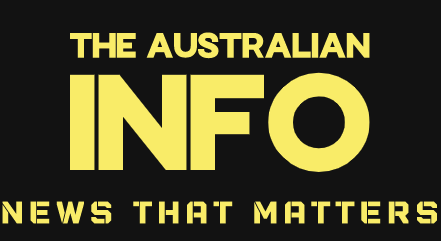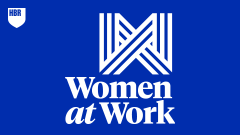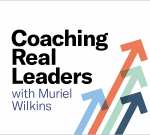Many of us have internal beliefs—I need it done now, I know I’m right, I need to be involved—that feel like truth but actually hold us back as leaders. Executive coach Muriel Wilkins calls these counterproductive beliefs “hidden blockers,” and she talks the Amys through the process of identifying theirs and then reframing them.
They also explore how blockers show up at the team and organizational level, like when lack of trust leads to a bloated meeting culture. Muriel shares how leaders can encourage mindset shifts in their organizations, beginning with themselves, and how to create conditions that allow others to examine what’s driving their behavior without judgment or overreach.
Guest expert:
Muriel Wilkins is an executive coach who hosts the HBR podcast Coaching Real Leaders and whose latest book is Leadership Unblocked: Break Through the Beliefs That Limit Your Potential.
Resources:
- “What Self-Awareness Really Is (and How to Cultivate It),” by Tasha Eurich
- “Becoming More Collaborative — When You Like to Be in Control,” by Jenny Fernandez and Luis Velasquez
- “Are You a Micromanager or Too Hands-Off?” by Carole-Ann Penney
- “How to Manage Someone Who Thinks Everything Is Urgent,” by Liz Kislik
- “The Insidious Effects of Hurrying,” by Kandi Wiens
Sign up for the Women at Work newsletter.
Email us: womenatwork@hbr.org
AMY GALLO: You’re listening to Women at Work from Harvard Business Review. I’m Amy Gallo.
AMY BERNSTEIN: And I’m Amy Bernstein. A regular guest of ours, executive coach Muriel Wilkins, is here with us yet again, yay, with her signature mix of candor and compassion.
MURIEL WILKINS: Hello. Thank you for having me here again.
AMY GALLO: Nice to have you back.
AMY BERNSTEIN: So great to see you.
AMY GALLO: Muriel, every time you’re on the show, you help us see what being a leader actually requires on the inside, and you’ve channeled that special gift into your latest book. Tell everyone what it’s called.
MURIEL WILKINS: Absolutely. So, my latest book is called Leadership Unblocked: Break Through the Beliefs That Limit Your Potential.
AMY BERNSTEIN: So, I have to be honest, I identified with several of those beliefs, but the one I focused on is the belief called “I need it done now.”
AMY GALLO: And I identified with another of them, the “I know I’m right,” which I understand, Muriel, is one you have struggled with as well.
MURIEL WILKINS: Yes. Have struggled with, struggle with, and probably will always struggle with, but with a little bit more ease.
AMY BERNSTEIN: So, we’ll go into detail about those hidden blockers and the steps you had us go through, which we strongly recommend our listeners go through too.
AMY GALLO: Yeah. We went from vague feelings of we know we need to make a change, all the way to concretely listing what we need to start and stop doing.
AMY BERNSTEIN: Not only so that we as individuals can reach our full potential, but also so that our teams can and our organizations can as well.
AMY GALLO: All right, so Muriel, before Amy B and I tell you about the awareness we got from reading and reflecting—and it was a bit of painful awareness at times—can you just tell us what you mean by a “hidden blocker” and how would someone know that’s what they have?
MURIEL WILKINS: Yeah. So, a hidden blocker is basically a belief. It lives on the inside of you, which is why it’s often hidden because you’re not even aware that it’s there. And a belief, for simplicity’s sake, is something that you think is true. We all have beliefs, and some of them are based on facts. Most of them are based on our perceptions—the lens through which we look at the world—which has quite frankly nothing to do with what’s happening at the moment but is a reflection of everything that has happened to us beforehand. So, the reason I call them hidden blockers is one, because we’re often not aware of them, so they are hidden until you can bring them to the surface. But second, they often block us from being able to reach the goals that we have for ourselves unwittingly because they are serving another purpose but not necessarily the purpose that you want to have, which is to reach whatever professional goals or personal goals that you have.
AMY BERNSTEIN: So, some of the signs that you describe of struggling with one or more of those blockers—they include low morale, stalled advancement, resentment—they sound like problems we blame on others. Why is it so hard to see that we might be the common thread?
MURIEL WILKINS: Think about it. When you have to blame yourself for something, what does it mean? It means that you have to do something about it. So, I think it’s very easy to look at others to blame for what might be happening. And in effect, it’s not say that others aren’t contributing to it, but what most of us don’t do is say, How am I contributing to the issue that’s at hand or the challenge that I’m facing? And when we can start looking at what our own contributions are, at the very least we can make some movement there; because once you start making movement, it will change the dynamic of the circumstance no matter what.
And in my role as an executive coach, which is what I’ve done for over 20 years now, my role is to help my clients or the individuals that I’m working with figure out how to be as successful as they can be within the context that they’re in. My role is not to change the context. And so as much as my clients hate it, at the end of the day, what I always tell them is, “you’re the one who’s sitting in front of me, so you’re the only one who I can work with in terms of making a difference. So, let’s talk about what choices you have in front of you for what you can do differently, keeping in mind again that everything is co-created.” So, the minute that one individual changes the way that they behave or respond, it automatically changes the dynamic.
AMY BERNSTEIN: So, my blocker, as I mentioned, is “I need it done now.” And I used to see that as one of my strengths—that you sent me an email, I responded almost immediately. Slack, even faster. And I hit this point of exhaustion not too long ago where I realized I cannot do that anymore. It was counterproductive, and it was burning me out. And so I realized that I was making this fundamental mistake, which was I was not separating the urgent from the important, and then relatedly, I was letting other people’s urgency be my urgency. And I realized from that, that I needed to first make the distinction between the urgent and the important and stick to it, not get blown with every puff of wind.
MURIEL WILKINS: Yeah. This is a really common one, and I want to touch on a few things that you said, Amy. The first is you used to think of this as a strength of yours. Well, the fact of matter is it was perceived as a strength of yours when it served you well in the capacity that you were in, probably when you were an individual contributor, earlier on in your career. I remember when I came out of college, my first job, and for a long time afterwards, that is what got me great credibility with my bosses. The minute they said jump, I was like, How high? Let’s go. I was more urgent than they were. I was figuring out what was urgent for them and solving it before it became urgent for them.
But then this belief though is one of the ones that really holds people back from leading at scale. So one of the things that’s key here is recognizing, are the mantras or beliefs or principles that we live by at certain points of our career or in certain organizations… do they necessarily serve us well when the situation or the context or the goal has changed? And in your case, it does not to continue with the “I want it done now” across the board because you are now leading at a much bigger scale with a lot of people wanting you to do things urgently—but not necessarily the most important things.
AMY BERNSTEIN: Right. And just to your earlier point about how hard it is to realize that these are things that are built on beliefs rather than facts, my behavior was habit. There was no mantra. It was decades and decades of habit. And so understanding it took some work.
AMY GALLO: And also I am realizing so much of this is internal work, but you have to undo what others look to you for.
MURIEL WILKINS: That’s right. A lot of people benefit from our behaviors and well, what is it going to mean now if Amy B is not responding to her all her emails within four hours? Oh my gosh. And so, all it means is that there’s a dynamic that now needs to be renegotiated. And that’s what I talk about is if you can own your part of the dynamic, the minute you make a change, the dynamic changes. So let it start with you.
AMY BERNSTEIN: Yeah.
MURIEL WILKINS: So, Amy B, let me ask you a question. If you had to reframe from “I need it done now” to a different belief that you think would best serve you right now, what would that be for you?
AMY BERNSTEIN: Well, so what I do now is before I even open my inbox or look at my Slack, I start out thinking, What do I need to get done today? What needs to happen so that everything else that needs to happen can happen? So, setting priorities and sequencing my own activities. And then when I look at the inbox, I’m scanning for the white-hot stuff that I need to deal with. And the rest of it, I just leave it unread.
MURIEL WILKINS: I hear that reframe as moving from “I need it done now” to “I need to focus on what actually needs to get done today.”
AMY BERNSTEIN: Exactly.
MURIEL WILKINS: Which, there’s a small nuance there.
AMY BERNSTEIN: Well, it’s also me taking control and not being controlled by other people’s requests. It was just super-responsiveness.
MURIEL WILKINS: Look, this is a really common one, and I think to really unpack it, you have to understand what the source of it is. Because this, “I need to do it now” did not just start a couple of years ago. And for everybody it’s different. I know for myself that I need to do it now came from a place of, the more productive I was, the more accolades I got. And that’s nice to get accolades, and so why not keep getting those accolades? At the end of the day, it was a way of being valuable. And so I had a strong identity to productivity being where I pinned all of my value until it came too much of a cost.
AMY GALLO: Yeah. Well, the blocker I identify most with the, “I know I’m right.” The point of this chapter where you start talking about things that may have led you to have this hidden blocker. I was a little like, Was she sitting in my therapy sessions? Because you were praised a lot for having the right answer. You were often told that you were smart and publicly recognized for it. You excelled academically. I was just like, oh my gosh, of course I ended up with this know-it-all blocker. It makes so much sense, and yet you’re blind to it because it serves you so well until it doesn’t.
MURIEL WILKINS: Until it doesn’t.
AMY GALLO: That was the interesting thing about reading that chapter is that you don’t try to convince the client example… Philip is his name in the chapter. You don’t try to convince him that he doesn’t know it all. You’re just trying to convince him that his arrogance and impatience is standing in his way. So, it’s not that he doesn’t have the right answers. I’m saying [laughter] it’s not that I don’t have the right answers; it’s that the fact that I’m not including others in the decision. I think the real cost of the blocker is that I end up making other people feel small because I don’t leave room for them. My thoughts, my ideas, my confidence takes up so much room that it just hurts the connection to be honest.
MURIEL WILKINS: And Amy G, if your goal was solely around knowing the answer, then we’re good. Keep doing what you’re doing. Keep being the first person to give the answer. Keep having the answer. But if you are now defining your success as, I want to make sure we get to the right answer, solving the problem is important, and I don’t want other people to experience being around me as being small or not included…if that is also part of my leadership, the way that I want others to experience my leadership, then in a way that belief is not supporting that goal. So, it always comes back to, What’s your goal? What is it that you want as a leader, how do you want others to experience you and as well as how do you want to experience yourself?
AMY GALLO: Yeah. Can I tell a… I don’t think I’ve ever shared this on the podcast. But when I realized this was a problem, this hidden blocker for me was when I was working as a consultant, I had a colleague who had become a good friend, and we were working on a project. And at the end of a meeting, he looked at me, and I’ll change the curse word, but he said, “Do you know at the end of every sentence, there’s a silent ‘you idiot’ that you don’t say, but it’s in your tone?” And he said it. At the time we laughed about it, ha ha, and I’m mortified, but that moment of feedback was really harsh. And yet, such a… I mean, thank you to Rosario, who gave me that, who took the leap to say that, because I had no idea.
MURIEL WILKINS: And Amy G, I have a story to one up on you. I went through the exact same thing. I literally rolled my eyes at someone. To this day I can see it. I remember doing it, and I know what was going through my head was I know the answer to this, and this person here doesn’t know what the heck they’re talking about. And this was very early on in my career, and I remember—it was in consulting as well. And the partner pulled me to the side, and he was like, “Okay. You can’t do that.” And I was like, “Do what?”
AMY GALLO: You mean, have every answer all the time?
MURIEL WILKINS: And he said, “I know you knew the answer, but that wasn’t your job in that meeting. Your job was to let the client get to the answer. You were just there to be supportive and to answer questions if they had them.”
AMY GALLO: Amy B and I are pretty aware at this moment of what our





